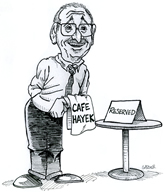When politicians such as President Trump and Sen. Bernie Sanders want to lower pharmaceutical prices, they resort to heavy-handed approaches through mandates. While that approach is direct and at least superficially logical, it’s not optimal. Instead of trying to force drug prices lower, we should make drug development cheaper.
Drugs are expensive to develop. If the government mandates lower prices, drug companies are squeezed and respond by developing fewer drugs—reducing innovation and the therapeutic choices desired by patients and doctors. Lowering the cost of drug development would foster more innovation, more therapeutic alternatives, more competition and lower prices for new drugs, which wouldn’t need to return outsize profits to pay for high development costs. It would be a win for everyone.
There’s an easy solution that won’t compromise safety—a solution that was once the law of the land and has strong evidence to suggest it worked better than the system we have today. From 1938 through 1962, the Food and Drug Administration required proof of safety before drug approval but not proof of efficacy. The approach was abandoned due to a significant misunderstanding of the thalidomide tragedy—when thousands of babies outside the U.S. were born with severe birth defects.
The issue with thalidomide was a failure of safety, not efficacy. But under pressure to react, Congress required, through the Kefauver-Harris Amendments of 1962, proof of efficacy before granting marketing approval. The new rule addressed a problem that didn’t exist and, in doing so, imposed a substantial new cost burden.
Before 1962, developing a drug took about two years. Now it takes 12 to 14 years. Since 1975 real development costs have risen about 7.5% a year, roughly doubling every decade. Today, we estimate that bringing one successful drug to market costs about $9 billion on average. (This includes the cost of failed drugs and the time value of money.)
Peter Earle ponders the American economy’s reactions to Trump’s trade ‘policy.’ A slice:
Trade policy rarely lands as a single shock. It comes in waves of announcements, exemptions, delays, and staged rollouts. Large swaths of consumer imports remain untouched or partially shielded. It is buffoonery to suggest that forecasts built on hypothetical outcomes — i.e., what would happen if tariffs were imposed as announced — should be judged against the vastly watered-down, and moreover capriciously imposed, regime that has actually been imposed. To argue otherwise is to miss the point entirely: policymakers often retreat precisely because the dire forecasts are credible. Most individuals — and economists especially — would rather base projections on a combination of theory and historical experience.
Trump’s tariffs are weighing heavily on American small businesses. (HT Scott Lincicome)
GMU Econ doctoral candidate Anna Claire Flowers writes with Edward Timmons about universal childcare.
The full story of national parks, however, might not comport with novelist Wallace Stegner’s 1983 declaration: “National parks are the best idea we ever had. Absolutely American, absolutely democratic, they reflect us at our best rather than our worst.”
A full and accurate history would recognize that national parks weren’t created democratically, nor are they a reflection of our best. They were created at the expense of Native Americans.
In 1872, President Ulysses S. Grant signed the law creating the first national park—Yellowstone. The Crow people’s reservation in the 1850s included the eastern half of what would become the park. By the 1860s, the U.S. government reduced the Crow’s land to a much smaller strip, and the park’s creation further encroached on tribal lands.
The creation of Yosemite National Park in 1890 gradually pushed out the Southern Sierra Miwok people, also known as the Ahwahneechee.
In 1895, facing starvation, the Blackfeet people reluctantly sold 800,000 acres to the U.S. government with the understanding that they would retain rights to hunt, fish and gather on the land. In 1910, when the land became part of Montana’s Glacier National Park, however, the Blackfeet lost those rights.
Ironically, the National Park Service logo is an arrowhead. Part of the service’s mission is to “preserve the scenery and the natural and historic objects,” but opening the gates to millions of visitors annually leads to overcrowding, not preservation. On an average day in July, Yellowstone receives more than 30,000 visitors.
George Will reflects on Andrey Mir’s reflections on modern media. A slice:
What Mir calls the “commodification of the Trump scare” has completed journalism’s transition from “making happy customers” for department stores and other advertisers, to “making angry citizens.” For what Mir calls postjournalism, the next challenge is to find a successor scare.
“The shift from rationality to emotionality and peddling intensities” has, Mir says, made negativity mandatory.



